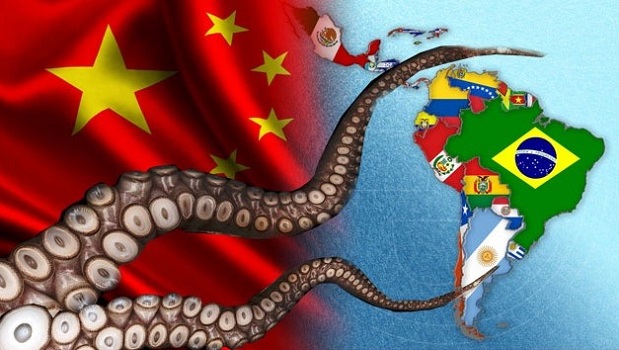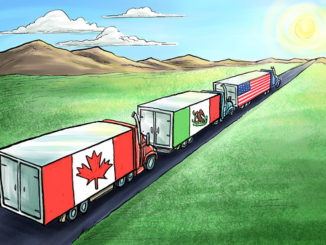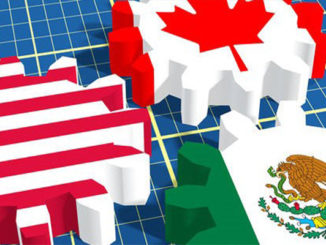
By Jose Cardenas
U.S. President Donald Trump’s opposition to the North American Free Trade Agreement and his withdrawal from the Trans-Pacific Partnership have led some critics to claim that the United States is turning its back to regional trading partners, and that Trump is thus freeing up China to make inroads into Latin America. But China’s presence in the Western Hemisphere is already well-established, having predated Trump’s election by almost 20 years. Beijing’s involvement in the region is subject to the ebb and flow of the region’s economic and political changes, but it stems from the needs both of China and corresponding Latin American capitals.
But if China’s position has long since become a fixture in the hemisphere, it is equally true that U.S. policymakers have been remarkably complacent over the years as the growing Chinese presence has necessarily impacted not only the region, but U.S. political, economic, and security interests. That needs to change.
China’s interest in Latin America is both economic and strategic. It was the accelerating Chinese economy’s voracious appetite for raw materials that keyed its entry to the region, a land of plenty when it comes to natural resources. Iron, soybeans, copper, and oil make up the bulk of Chinese imports from the region. In turn, securing access to Latin American markets for the export of Chinese manufactured products became a priority as well.
Economic Push
The numbers are staggering. China joined the World Trade Organization in 2001, and its bilateral trade with Latin America and the Caribbean has since skyrocketed, from $15 billion in 2001 to $288.9 billion in 2013 — an increase of almost 2000 percent. That number now represents 6 percent of China’s total foreign trade, an increase from 2.7 percent in 2000. (Some 13 percent of Latin America’s trade is now done with China, up from negligible levels in 2000.)
In the past decade, China’s two biggest development banks have provided $125 billion to Latin America — more than the combined total lending of the World Bank and the Inter-American Development Bank. China is now Latin America’s largest creditor. In addition, between 2000 and 2015, Chinese leaders visited the region more than 30 times.
Last November, Chinese President Xi Jinping made his third trip to the region since 2013, announcing a plan to double bilateral trade and to increase investment stock value by 150 percent over the next decade.
Not Just Economics
China also has significant geopolitical interests. It wants to project power and influence in an area long considered to be within the U.S. sphere of influence — no doubt a response to what Beijing considers U.S. efforts to contain and encircle China in Asia by cultivating allied and friendly governments.
Critical to China’s aspirations as a growing global power as well is what it calls global governance reform. In translation, that means Beijing uses its growing trade and financial might to challenge the architecture of the U.S.-dominated post-World War II order and alter it along lines more favorable to China. Beijing sees developing its own alliances through trade and loans as an important way to counterbalance U.S. influence and to secure support in multilateral forums on such important issues to Beijing as human rights, climate change, and economic governance.
It bears noting that China considers its principal regional economic and political interlocutor to be the Community of Latin America and Caribbean States, an organization established by the late Venezuelan firebrand Hugo Chavez that purposefully excludes the United States and Canada.
Finally, it is no coincidence that of the 22 countries that diplomatically recognize Taiwan, 12 are in Latin America and the Caribbean. China wants specifically to erode this support for Taipei. As a Chinese white paper on Latin America and the Caribbean in 2008 put it succinctly, “the One China principle is the political basis for the establishment and development of relations between China and Latin America.”
Changing Times
Chinese demand for commodities keyed its entry into the region and helped produce one of Latin America’s fastest periods of growth in decades, but the times are changing. Lackluster global economic growth and the cooling Chinese economy (which has contributed to the end of the global commodity boom) have resulted in a drop in Chinese imports from and exports to Latin America in recent years. Indeed, over the past year regional revenues from commodity exports to China dropped some 40 percent.
Latin America is also changing politically. China’s initial push into the Western Hemisphere was facilitated by the rise to power of a host of leftist populist governments — a phenomenon collectively referred to as the Pink Tide. Many leaders, foremost among them Venezuela’s Hugo Chavez, were determined to distance themselves from the United States and from institutions perceived to be allied with Washington. These leaders were happy to align themselves with China, which adheres to a supposed policy of non-interference in countries’ internal affairs. That equally suited a number of Latin American governments, which proceeded to undermine democratic institutions and the rights of their citizens.
However, with the bust in oil prices and other commodities exposing the economic dysfunction of the populist model, frustrated voters are shifting their support to more pragmatic, market-friendly governments. These governments can be expected to operate in a more sober and transparent manner, and to be more respectful of democratic institutions, eschewing the opaque, behind-the-scenes deals that China previously thrived on. With less opportunity to present itself as the buyer or lender of last resort, China will find itself needing to adapt to a more challenging and competitive environment.
Beijing seems to be adjusting well: China’s evolving economic strategy is now one of diversification, with an emphasis less on traditional industries such as mining and energy extraction and more on sectors such as infrastructure (including energy, airports, seaports, and roads), construction, telecommunications, manufacturing, finance, agriculture, tourism, and even the space sector.
Implications for the United States
China’s authoritarianism, global designs, and disregard for international norms and practices raise serious questions about the impact of its engagement in the Western Hemisphere on the promotion of democracy, human rights, and the rule of law. In recent congressional testimony, U.S. Southern Commander Adm. Kurt Tidd put it like this:
For Russia, China, and Iran, Latin America is not an afterthought. These global actors view the Latin American economic, political, and security arena as an opportunity to achieve their respective long-term objectives and advance interests that may be incompatible with ours and those of our partners. Their vision for an alternative international order poses a challenge to every nation that values non-aggression, rule of law, and respect for human rights — the very same principles that underlie the Inter-American system of peace and cooperation. Some of what they’re doing — while not a direct military threat — does warrant examination. Even seemingly benign activities can be used to build malign influence.
This was certainly evident in recent years, with China providing anti-American governments with an alternative source of trade, investment, and finance outside conventional institutions that ordinarily require some conditionalities on good governance, transparency, anti-corruption efforts, human rights, and the rule of law. In some cases, it didn’t create major problems. In others, such as Venezuela ($65 billion in Chinese loans) and Ecuador ($11 billion), Beijing bankrolled authoritarianism and human rights abuses, undercutting U.S. efforts to promote its policy agenda in the Americas and setting the stage for the chaos now underway in Venezuela.
Yet it is not as though the United States can block or impede Chinese trade and investment in the hemisphere. It is also important to keep things in perspective: U.S. trade with Latin America is still three times larger than China’s. Nor can China match our proximity, cultural and familial ties, and long shared history. The best response therefore to the Chinese presence in the Western Hemisphere is to do what the United States does best: compete.
The situation is best approached as a strategic competition in which the United States employs its comparative advantages and the above described strengths to secure its role as the preferred partner of choice for our Latin American neighbors. China may have the cash advantage, but it cannot compete with the United States in terms of the aforementioned, nor in the agreements shared throughout the Western Hemisphere on rules-based behavior, transparency, and a belief in economic opportunity, strong institutions, and the rule of law. The United States also boasts a 50-year record of promoting sustainable long-term regional development and humanitarian projects, a commitment to corporate social responsibility, and — not to put too fine a point on it — laws that prohibit bribery and other corrupt practices that often undermine the public’s faith in their systems.
This is in contrast to the Chinese presence, where cultural differences, radically divergent value systems, and different ways of doing business often impair mutual understanding and trust. China also has a poor record on human rights, anti-corruption practices, and environmental and labor conventions. (In many cases, Chinese construction companies import Chinese workers, spurring local resentments over lost employment opportunities.)
On the economic front, many economists worry that China’s demand for raw materials harkens back to Latin America’s bad old days of too much dependence on commodity exports. Neither do they see purchasing Chinese manufactured goods in return as being conducive to long-term development. Again, in contrast, the United States provides meaningful value-added, job-creating investment in the region while purchasing the sort of manufactured goods that generate more jobs.
Game On
Whatever professions of a win-win economic situation for all, or of China’s benign intent, China’s position in Latin America affects the U.S. agenda and regional stability — and Beijing has the resources and motivation needed to adapt to changing circumstances and to remain such a regional fixture for the foreseeable future. That is why U.S. complacency is not an option. Competition need not be hostile, just determined. In particular, the Trump administration has an excellent opportunity to press the U.S. advantage by drawing closer to regional heavyweights Brazil and Argentina, who are attempting to shake off the legacies of years of statist economics. These are countries where China has been particularly active. Each now has a market-friendly president desperate to produce economic growth and draw foreign investment.
A reinvigorated U.S. engagement with the hemisphere will reap significant benefits for the U.S. economy. It will create new investment opportunities, including in the energy sector, but it will also drive up the cost of doing business for Beijing. That China continues to expand its presence in other regions such as Asia and Africa is one thing, but encroaching in our own neighborhood more directly impacts the U.S. national interest. It’s time for America to pay closer attention.
José R. Cárdenas is a director with the international consultancy Vision Americas. He served in several senior foreign policy positions during the George W. Bush administration (2004-2009), including at the Department of State, the National Security Council, and the U.S. Agency for International Development. This piece is part of a special RCW series on the U.S.-China geopolitical relationship. The views expressed here are the author’s own.



